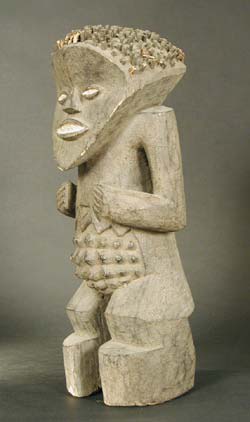Mambila Wooden Sculpture, 20th Century CE
Wood
6 x 17.25
PF.4449
In the art of sculpture, it is possible to convey many emotions. Through skill and creativity, the human form can be seen in its most pure and elemental state. Within...
In the art of sculpture, it is possible to convey many emotions. Through skill and creativity, the human form can be seen in its most pure and elemental state. Within the Mambila tribe, a sculptor could easily acquire a reputation for excellent work. Men were in charge of weaving cotton, metal-wood working and braiding fiber. The sculptor in wood often used raffia fronds and employed a technique of burning pieces with preheated scissors, which gives a lovely patina.
On this particular sculpture the irregular surface of the adze tool is apparent, making the viewer's connection with the artist even more vivid. The impression of movement is remarkable: he is charging forward with great determination, hands clenched at the waist, mouth open wide seeming to declare nothing will stand in his way! His hair is done in such a method as to be both representational and abstract, as is the studded skirt and zigzag waistband. It is, however, the feet that are so fascinating. Though simply carved they are very expressive, as if in motion, an effect made even more dramatic by the slightly bent knees, giving the whole figure wonderful animation.
On this particular sculpture the irregular surface of the adze tool is apparent, making the viewer's connection with the artist even more vivid. The impression of movement is remarkable: he is charging forward with great determination, hands clenched at the waist, mouth open wide seeming to declare nothing will stand in his way! His hair is done in such a method as to be both representational and abstract, as is the studded skirt and zigzag waistband. It is, however, the feet that are so fascinating. Though simply carved they are very expressive, as if in motion, an effect made even more dramatic by the slightly bent knees, giving the whole figure wonderful animation.
